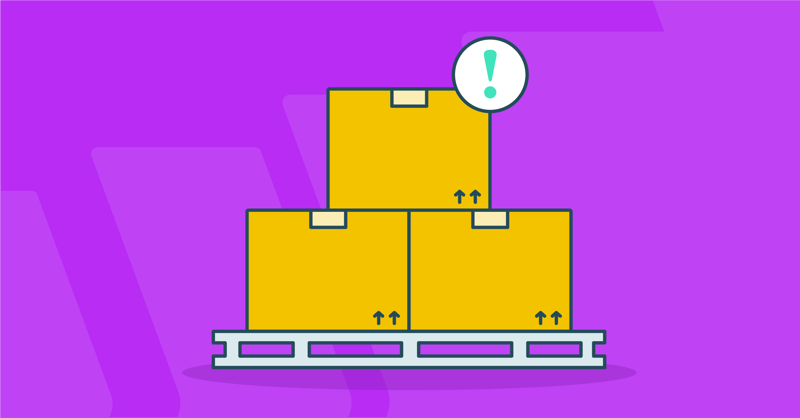Updated: November 15, 2021

If you’re here because your FBA inventory limits were recently restricted by Amazon without warning, you’re not alone. On Monday, May 24, 2021, many third-party (3P) sellers woke up to find that their maximum inventory capacity had been reduced by Amazon ranging from 25-60%.
At SupplyKick, our inventory levels were slashed in half overnight. These FBA inventory restrictions are happening during a critical time period for sellers prepping for Amazon Prime Day 2021, leaving many wondering why they’ve been hit with such a curveball right now (especially those who have already stocked up for the big event).
Though Amazon has not yet released official statements addressing the sudden stock restrictions for FBA sellers, we do have a few theories here at SupplyKick. Keep reading for what happened, what we know so far—and what sellers can do about it:
Here’s the play by play: On the morning of Monday, May 24, numerous 3P sellers leveraging FBA (fulfilled by Amazon) woke up to learn that their inventory capacity in Amazon’s fulfillment centers had been reduced overnight. This came without warning or notification from Amazon.
In SupplyKick’s case, it was a typical Monday morning for our logistics team as they logged onto Seller Central to create shipments for the week. That’s when we saw that our maximum inventory levels were adjusted drastically. All of a sudden we were over our lot limit, and our oversized restock limits had been cut by 58%. More than half of our partners have also seen their inventory maximums drop.
Many other sellers experienced similar issues of seeing maximum inventory reduced by 25%, with the highest cuts reported upwards of 60%. Sellers carrying Oversize stock saw limits cut in half or even by two-thirds overnight.
FBA inventory maximums usually only fall when a seller isn’t in good standing with Amazon, as measured by an IPI (Inventory Performance Index) score. But many sellers, including SupplyKick, who reported the sudden inventory drops claim to have IPI scores in the green.
While it’s complete speculation—Amazon has not specifically addressed the recent inventory restrictions for FBA sellers—we believe Amazon is cutting capacity for 3P sellers to make room for its own products/inventory in advance of Prime Day.
When SupplyKick first saw our inventory maximums adjusted at the end of May, we emailed Amazon for more information. Their response was vague and blamed COVID-19 for the reduced capacity and restock limits:

When Modern Retail reached out to Amazon, they received this response: “We continually assess and update restock limits based on many factors, including past and future sales, current inventory levels, new selection, and the capacity available in our fulfillment centers.”
When sellers hit their new FBA inventory restriction limit, it means that what sellers have in stock currently at Amazon warehouses stays put. But now sellers can’t send any more inventory because they’ve already “hit their max” according to Amazon. In order to send in more inventory, FBA sellers have to sell through what is now considered by Amazon as “over” stock levels. Until a seller’s utilization quantity goes below their maximum inventory level, they can’t ship any more product into Amazon fulfillment centers.
Now, most FBA sellers know and expect for inventory limits to be dynamic. Amazon ties a seller’s inventory storage to IPI performance, and if you aren’t turning inventory out in a timely manner, Amazon will make tweaks. But the cuts numerous sellers saw in May 2021 are drastic—and it’s a huge challenge for third-party sellers still trying to navigate ongoing supply chain issues that have been happening since the start of the pandemic.
Numerous 3P/FBA sellers are impacted, and those with oversized products are even more affected by these recent restrictions. Many brands across product categories have spoken up on Reddit about sudden inventory limitations, but here are a few groups directly impacted:
Amazon definitely zeroed in on FBA sellers with oversized inventory in particular—cutting Oversize inventory capacity as much as 50-65% overnight. And we’re not just talking about furniture and refrigerators. Oversized inventory is defined by Amazon as “any packaged unit that weighs more than 20 lbs or with its longest side more than 18", its shortest side more than 8", or its median side more than 14". A Unit exceeding any of these dimensions is Oversize.”
According to these specs, even a yoga mat could be considered Oversize by Amazon—so these restrictions could have affected thousands of sellers.
Put simply, affected Prime Day sellers are not able to send in the additional inventory they wanted to this year, meaning they might have to limit the advertising and deals they intended to run—and ultimately expect a decrease in Prime Day 2021 sales.
Amazon officially announced Prime Day dates on June 2, 2021, just three weeks before the big event. Many Amazon brands were already predicting an earlier Prime Day, and forward-thinking FBA sellers began increasing their inventory early in anticipation. But sellers who were hit with sudden storage restrictions are not able to send in any more Prime Day inventory and must sell what’s there before sending in additional stock.
Even without the current restock limits, three weeks to prep for Prime Day is a crazy-tight inventory timeline—it can take weeks for products to be processed, received in their fulfillment center (FBA), and appear in stock on Amazon, so what’s in stock now for sellers is likely what they’ll have on hand during the two-day event.
Sellers who have a super seasonal assortment right now (Sports & Outdoors, Patio, Lawn & Garden, Tools & Home Improvement, and more) are affected because chances are they have higher stock levels at the moment due to seasonal demand. They’ve probably bulked up their safety stock over the past few months in anticipation of increased product sales and even Prime Day.
If these sellers have been hit with sudden inventory limitations, they’ll have to work through some of their now “excess” inventory before they can send more into Amazon. This sets up seasonal sellers for a very disrupted workflow and the potential to stock out quickly because they can’t send in higher quantities of inventory, which leads us to…
Ultimately, many FBA sellers may end up experiencing more product stock outs (which are already rampant due to continued supply chain issues) because their available inventory capacity has been cut in half. You can’t make money on Amazon if your products aren’t in stock, period, so this could get ugly for many sellers.
Similar to those preparing for Prime Day, sellers trying to send in more inventory now or a few months from now for other big-time shopping events may be facing the same issues. If these stock restrictions are causing a ripple effect right now, some expect this to be an ongoing issue that may limit sales potential for the 2021 holiday season.
To our knowledge, Amazon has not yet addressed these overnight stock restrictions in relation to Prime Day specifically, nor have they stated when these limitations will be lifted.
At SupplyKick, we are predicting FBA inventory capacity to be limited at least through Prime Day. Other sources are skeptical that restrictions could continue into Q3, Q4, and potentially beyond—but only time will tell.
For those preparing for Prime Day, follow this guide ASAP for quick wins to set yourself up for success. For the inventory you do have plenty of stock in for Prime Day 2021, keep your focus the next few weeks on:
Looking beyond Prime Day, continue to forecast your inventory through the rest of the year based on your latest stock limitations as best you can—and keep track of upcoming major shopping holidays and send-in dates. Continue to reach out to Seller Support for answers on why restock limits have been adjusted. (Maybe power in numbers will facilitate a response?)
Finally, consider teaming up with an experienced 3P seller or agency who can help you navigate these marketplace complexities and offset inventory management, brand marketing and Amazon advertising, case management, customer service support, and more. Connect with our team to learn how SupplyKick can help.
Lorem ipsum dolor sit amet, consectetur adipiscing elit


Sign up to receive our newsletter for growth strategies, important updates, inventory and policy changes, and best practices.
These Stories on Logistics & Fulfillment
For press inquiries, please contact Molly Horstmann, mhorstmann@supplykick.com